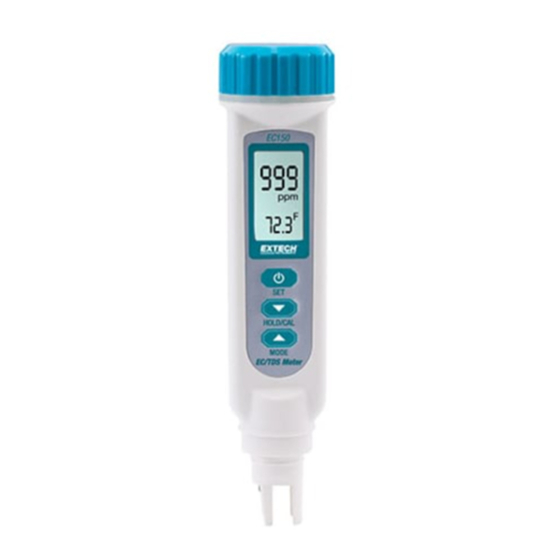
Table of Contents
Advertisement
Quick Links
Advertisement
Table of Contents

Summary of Contents for Extech Instruments CT-3060
- Page 1 User's Guide Conductivity and TDS Meter Pen Style Water Quality Meter Mobile: +62 816 1740 8925 Office: Jl. Radin Inten II No. 62 Duren Sawit, Jakarta 13440 - Indonesia Workshop: Jl. Pahlawan Revolusi No. 22B, Jakarta 13430 - Indonesia Fax: 021-8690 6777 Phone: 021-8690 6777 (Hunting)
-
Page 2: Supplied Materials
Introduction Congratulations on your purchase of the Extech Pen Style Water Quality instrument; the Model EC150 measures Conductivity and TDS (Total Dissolved Solids) plus Temperature. The instrument is housed in an IP65 Water-proof enclosure for safety. This instrument is shipped fully tested and calibrated and, with proper use, will provide years of reliable service. -
Page 3: Meter Description
Meter Description Battery Compartment Display Keypad Electrode Electrode protective cap Display Description Data Hold icon Micro- and milli-Siemens units Primary measurement reading Parts per thousand and parts per million units Temperature reading Temperature units of measure Battery strength indicator Calibration icon Keypad Description Power ON-OFF and SET button Down Arrow, Data Hold, and Calibration button... -
Page 4: Operation
Operation Getting Started 1. Remove the probe’s protective cap (bottom of meter) by pulling the cap firmly downward, away from meter, until it snaps off (see diagram). 2. Press the power button to power ON the meter. The meter display will cycle through several icons (representing the current configuration of the meter) before settling on the main display as shown in the display description above. -
Page 5: Setup Mode
TDS (Total Dissolved Solids) and Conductivity Measurements 1. Read the Measurement Preparation section above before continuing. 2. Use the MODE button to switch between the TDS and the Conductivity measurement modes. In TDS mode the unit of measure is ppt (parts per thousand) or ppm (parts per million). In Conductivity mode the units of measure are µS or mS (micro- or milli-Siemens). - Page 6 Parameter P2: TDS Conversion Factor 1. If continuing from Parameter P1 skip directly to step 2 below. If starting from the normal operating mode, press and hold the SET button for at least 2 seconds until the ‘Px’ icon appears on the meter display (x = setup parameter number).
- Page 7 Calibration Calibration Preparation and Considerations The user must first determine: 1. The best calibration schedule for the application at hand. 2. What calibration standard to use. Calibration Schedule Calibration is necessary and should be performed regularly. If measuring in the mid-ranges calibrate the meter at least once per month and soak the probe for 15 minutes before each use.
-
Page 8: Maintenance
TDS (Total Dissolved Solids) Calibration Procedure TDS CALIBRATION OPTION 1 Allow the probe to soak in de-ionized or distilled water for 30 minutes. Select an appropriate TDS calibration standard. The factory default TDS conversion factor setting is 0.50. To change this value to better match the TDS factor of a particular calibration solution, refer to the Setup section. -
Page 9: Troubleshooting
Troubleshooting Power ON is attempted but there is no display Be sure to press the ON-OFF but for at least 100mS to switch the meter ON. Check that batteries are positioned correctly, making good contact, and follow correct polarity. ... -
Page 10: Appendix A: Factory Default Settings
Appendix A: Factory Default Settings Type Parameter Default Notes P1.1 Select °C/°F °C Temperature units P1.2 Normalized Temperature (reference temperature) 25°C Select 20°C or 25°C P1.3 Temperature Coefficient 2.1% / °C Adjust from 0.4 to 10% P2.1 TDS Factor 0.50 Adjust from 0.40 to 1.00 P3.1 Revert to Factory Default settings... -
Page 11: Appendix D: Temperature Effects
Appendix D: Temperature Effects Conductivity measurements are temperature dependent; if the temperature increases, conductivity also increases. For example, the conductivity measured in a 0.01 M KCL solution at 20°C is 1.273mS/cm, whereas, at 25°C, it is 1.409 mS/cm. The concept of reference temperature (normalization temperature) was introduced to allow the comparison of conductivity results obtained at different temperatures. -
Page 12: Specifications
Specifications General Specifications Measurement ranges Conductivity: 0 to 1999µS and 0 to 19.99mS TDS: 0 to 1999ppm and 0 to 19.99ppt Accuracy Conductivity and TDS: 1% Full Scale ±1digit Resolution Conductivity: 1µS and 0.01mS TDS: 1ppm and 0.01ppt Temperature Accuracy ±0.5°C Temperature Resolution 0.1°C/°F...















Need help?
Do you have a question about the CT-3060 and is the answer not in the manual?
Questions and answers